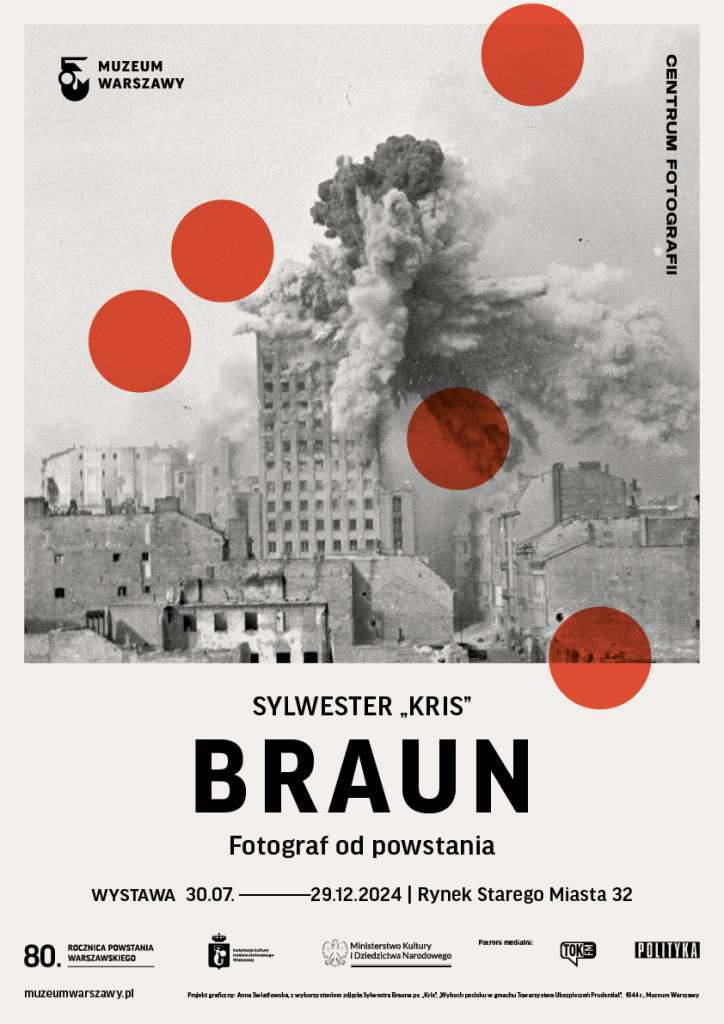Sylvester "Kris" Braun. Photographer since the Uprising - a unique exhibition and book for the 80th anniversary of the Warsaw Uprising

30.07.2024 / Rynek Starego Miasta 32 / Warsaw

Photographs by Sylwester "Kris" Braun are some of the most important documents of the Warsaw Uprising. The Museum of Warsaw presents in the exhibition Sylwester "Kris" Braun. Photographer from the Uprising original prints made by Braun. It poses the question of when and how a biographical account becomes a historical narrative, and reveals the figure of Berta Weissberger, Braun's assistant. Also premiering on July 30 is an album with the same title, in which more than two hundred photographs are accompanied by texts by Piotr Glogowski, Iwona Kurz, Tomasz Stempowski and Tomasz Szerosz describing hitherto unknown fragments of Braun's biography, analyzing the photographer's workshop and itineraries, as well as the iconography of the uprising photographs. The exhibition and album are part of the celebrations of the 80th anniversary of the Warsaw Uprising prepared by the Warsaw Museum.
Sylvester "Kris" Braun is one of the most important photographers of the Warsaw Uprising. Many of the frames he took in 1944 have become iconic. They are referenced and widely recognized as images of the uprising, even when unsigned. Braun's original prints are the most valuable objects about the Warsaw Uprising in the photographic collection of the Museum of Warsaw. Their presentation in the form of an album and exhibition will honor the 80th anniversary of the August uprising.
On July 30 at 6 p.m. there will be a book launch meeting and the opening of an exhibition under the joint title Sylvester "Kris" Braun. Photographer since the Rise. The authors of the book will talk about the photographs and Braun's character in the Lapidarium of the Warsaw Museum in the Old Town Square. The meeting will be moderated by Karolina Puchała-Rojek of the Warsaw Museum's Center of Photography. This will be followed by the opening of the exhibition, which will be on view as part of the Warsaw Museum's main exhibition until December 29, 2024.
- The history of the photographs taken by Braun is not limited to the moment he exposed the negatives, says Piotr Glogowski, curator of the exhibition. - Their turbulent fate consists of: their hiding, finding, wandering around the world, the disappearance of a significant part of them, and their inclusion in the museum collection. New light is also shed on Braun's persona and work by identifying and finding his assistant, and at the same time the author of some of the photographs - Berta Weissberger, who, after emigrating to the United States and marrying, adopted the name and surname Betty Lauer.
The exhibition Sylwester "Kris" Braun. Photographer since the Uprising is a unique opportunity to see the author's prints made by Braun, trace the routes the pair of photographers took through fighting Warsaw and see how the documentary recording of events became a widely known story of the Warsaw Uprising.
The exhibition captures the photojournalistic nature of Braun's photographs, which is largely due to the fact that they are arranged in a closed, thoughtful series. The shots show on a micro scale the everyday life of the fighting capital, its heroic moments, sometimes joyful, but also poignant and tragic. A post at the barricade, a piano concert, the drilling of a well are seemingly trivial subjects that gain a solemn meaning when juxtaposed with other, parallel events, for example, the funeral of victims, a ride in a captured transporter, the escorting of a column of prisoners of war.
Braun's biography and, above all, the reinstatement of Berta Weissberger as an important character in the story, shows how many factors influence the creation and reception of historical narratives. Already during the uprising, Braun had a pass allowing him to move freely in the liberated areas of the capital, he chose his own subjects and the scenes he photographed, and submitted selected prints to the Office of Information and Propaganda of the Home Army for distribution. After the war, he made attempts to distribute the photographs, and when the political situation in the 1980s and 1990s allowed the iconography of the uprising to return and Braun himself to Poland, he was actively involved in preparing exhibitions and book publications.
Thanks to the many years of research by exhibition curator Piotr Glogowski, the locations captured in the photographs, the dates of the day and even the time of day when they were created have been identified. This made it possible to reconstruct the routes of the wanderings and re-arrange the strips of negatives cut by Braun into rolls.
The themes explored in the exhibition are developed in an album titled Sylvester "Kris" Braun. Photographer since the Uprising. The fascinating fate and rich work of one of the most important photographers of the 1944 Uprising is brought closer by texts by Piotr Glogowski, Iwona Kurz, Tomasz Stempowski and Tomasz Szeresz. The publication charts Braun's wanderings in insurgent Warsaw, analyzes his photographic technique, but also places his work in the context of other photographers of August and September 1944. No less important is the legend Braun created about himself, and the role he and his photographs play in the current narrative about the Warsaw Uprising. The album contains more than two hundred photographs by Braun, primarily from 1944, as well as a selection of newspaper clippings and excerpts from correspondence. The book was published in Polish-English.
The publication and exhibition are part of the celebrations of the 80th anniversary of the Warsaw Uprising prepared by the Warsaw Museum. The program includes meetings, concerts, walks, debates, film screenings and presentations of memorabilia from the period.
